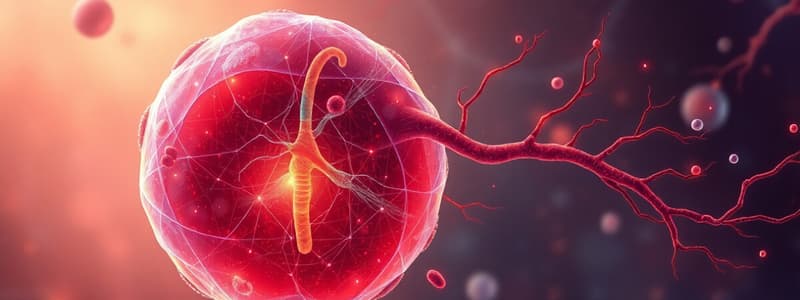Podcast
Questions and Answers
What is the main purpose of aerobic cellular respiration?
What is the main purpose of aerobic cellular respiration?
- To produce glucose from fatty acids
- To convert carbon dioxide into oxygen
- To release thermal energy only
- To obtain energy from food using oxygen (correct)
How much energy from aerobic cellular respiration is typically stored in ATP?
How much energy from aerobic cellular respiration is typically stored in ATP?
- 36% (correct)
- 100%
- 64%
- 50%
Where does gas exchange primarily occur in larger multicellular animals?
Where does gas exchange primarily occur in larger multicellular animals?
- Between the cells and tissues exclusively
- At the lungs and heart
- At the lungs and cells (correct)
- Only at the skin surface
What is the role of tissue fluid in the process of gas exchange?
What is the role of tissue fluid in the process of gas exchange?
What does the process of ventilation involve?
What does the process of ventilation involve?
What is the primary function of the respiratory membrane in the alveoli?
What is the primary function of the respiratory membrane in the alveoli?
What role do cilia play in the respiratory system?
What role do cilia play in the respiratory system?
How does the partial pressure of oxygen in the alveoli compare to that in the capillaries?
How does the partial pressure of oxygen in the alveoli compare to that in the capillaries?
What percentage of oxygen is typically transported by hemoglobin in red blood cells?
What percentage of oxygen is typically transported by hemoglobin in red blood cells?
What is the effect of increased hydrogen ions on blood plasma?
What is the effect of increased hydrogen ions on blood plasma?
Altitude sickness occurs primarily due to a decrease in what?
Altitude sickness occurs primarily due to a decrease in what?
What happens during inspiration when the diaphragm contracts?
What happens during inspiration when the diaphragm contracts?
Which component makes up the majority of carbon dioxide transport in the blood?
Which component makes up the majority of carbon dioxide transport in the blood?
Which factor triggers an increase in breathing rate?
Which factor triggers an increase in breathing rate?
What is the total lung capacity?
What is the total lung capacity?
During expiration, which muscle group relaxes to aid in the process?
During expiration, which muscle group relaxes to aid in the process?
Which of the following accurately describes residual volume?
Which of the following accurately describes residual volume?
What is the primary function of erythropoietin (EPO) produced by the kidneys at high altitudes?
What is the primary function of erythropoietin (EPO) produced by the kidneys at high altitudes?
What is meant by vital capacity in lung function?
What is meant by vital capacity in lung function?
Flashcards
Aerobic Cellular Respiration
Aerobic Cellular Respiration
The process by which cells use oxygen to release energy stored in glucose, producing carbon dioxide and water as byproducts.
ATP (Adenosine Triphosphate)
ATP (Adenosine Triphosphate)
The energy released from aerobic cellular respiration is stored in this molecule, which is used to power cellular processes.
Ventilation
Ventilation
The process of moving oxygen-rich air into the lungs and carbon dioxide-rich air out of the lungs.
Gas Exchange in Lungs
Gas Exchange in Lungs
Signup and view all the flashcards
Gas Exchange in Cells
Gas Exchange in Cells
Signup and view all the flashcards
Respiratory Membrane
Respiratory Membrane
Signup and view all the flashcards
Alveoli
Alveoli
Signup and view all the flashcards
Partial Pressure
Partial Pressure
Signup and view all the flashcards
Alveolar Oxygen Pressure (PO2)
Alveolar Oxygen Pressure (PO2)
Signup and view all the flashcards
Hemoglobin
Hemoglobin
Signup and view all the flashcards
Oxygen Carrying Capacity
Oxygen Carrying Capacity
Signup and view all the flashcards
Tissue Carbon Dioxide Pressure (PCO2)
Tissue Carbon Dioxide Pressure (PCO2)
Signup and view all the flashcards
Carbaminohemoglobin
Carbaminohemoglobin
Signup and view all the flashcards
Inspiration
Inspiration
Signup and view all the flashcards
Expiration
Expiration
Signup and view all the flashcards
Total Lung Capacity
Total Lung Capacity
Signup and view all the flashcards
Tidal Volume
Tidal Volume
Signup and view all the flashcards
Inspiratory Reserve Volume
Inspiratory Reserve Volume
Signup and view all the flashcards
Expiratory Reserve Volume
Expiratory Reserve Volume
Signup and view all the flashcards
Residual Volume
Residual Volume
Signup and view all the flashcards
Study Notes
Aerobic Cellular Respiration
- Cells require oxygen to survive and obtain energy from food.
- Aerobic cellular respiration is the process.
- Glucose reacts with oxygen, producing carbon dioxide and water, releasing energy.
- 64% of energy released is thermal energy.
- 36% is stored in adenosine triphosphate (ATP) molecules.
- ATP powers cellular processes like growth, movement, and molecule building.
Gas Exchange and Ventilation
- Gas exchange involves oxygen diffusing into cells, and carbon dioxide diffusing out.
- Simple organisms diffuse directly through cell membranes.
- Larger organisms use specialized organ systems (e.g., lungs) for efficient gas exchange.
- Gas exchange occurs at cells and lungs.
- In lungs, oxygen diffuses into the bloodstream for transport throughout the body.
- At cells, oxygen diffuses from the blood into tissue fluid.
- Cells release carbon dioxide into the tissue fluid, bloodstream and eventual removal in lungs.
- Ventilation moves oxygen-rich air into and carbon dioxide-rich air out of the lungs.
Respiratory Structures
- The human respiratory system has key features for effective gas exchange.
- A thin, permeable respiratory membrane for diffusion.
- Large surface area for efficient gas exchange.
- Extensive blood supply to facilitate oxygen uptake and carbon dioxide removal.
- The lungs are the main sites for gas exchange.
- Lungs contain a respiratory membrane with a large surface area and abundant blood supply.
- Situated within the thoracic cavity, protected by the rib cage.
Air Pathway
- Air enters the body through the nose or mouth.
- Nasal passages warm and moisten the air, filtering dust and particles.
- The pharynx connects the nasal passages/mouth to the trachea.
- The epiglottis covers the glottis during swallowing.
- The trachea is a semi-rigid tube, supported by cartilage to maintain its structure.
- It's lined with mucus-producing cells and cilia for trapping foreign particles and moving them out.
- The trachea branches into two bronchi, leading to the lungs.
- Bronchi branch into smaller bronchioles.
- The bronchioles terminate in alveoli.
- Alveoli are tiny sacs where gas exchange occurs and are in enormous numbers to maximise gas exchange.
Gas Exchange in Alveoli
- Alveoli are filled with fresh air at 37°C.
- The respiratory membrane is also moist (essential for oxygen diffusion).
- Oxygen must be dissolved in liquid to diffuse across the membrane.
- The alveoli have a very thin (single-cell-layer) membrane for rapid diffusion.
Partial Pressures
- Air pressure is measured in kilopascals (kPa).
- Atmospheric pressure at sea level is 101.3 kPa.
- Partial pressure is the pressure contributed by each gas.
- Oxygen makes up approximately 20.9% of air.
- Carbon dioxide makes up approximately 0.0391% of air.
Oxygen Transport and Diffusion
- PO2 in alveoli is higher than in capillaries, driving oxygen into the capillaries.
- Hemoglobin, a protein in red blood cells, binds to oxygen (forming oxyhemoglobin) to carry oxygen.
- Hemoglobin carries oxygen about 70 times better than if dissolved in blood plasma.
- At tissues, oxygen diffuses into cells.
- Blood returning to the heart still contains oxygen.
Carbon Dioxide Transport and Diffusion
- Carbon dioxide, a cellular respiration byproduct, must be removed.
- CO2 diffuses from tissues into the bloodstream.
- 7% dissolves in plasma, 20% attaches to hemoglobin and 73% forms carbonic acid.
- Excess hydrogen ions are carried on hemoglobin to prevent dangerously low blood pH.
- In the lungs, CO2 diffuses from the blood into the air.
Altitude and Respiration
- Atmospheric pressure and oxygen partial pressure decrease with elevation.
- Low oxygen levels at high altitudes cause altitude sickness.
- The body responds by producing more red blood cells to compensate.
Mechanism of Ventilation
- Inspiration: External intercostal muscles contract, diaphragm contracts, increasing thoracic cavity volume and lowering pressure thus drawing air into the lungs.
- Expiration: Intercostal muscles relax, diaphragm relaxes, decreasing thoracic cavity volume and increasing pressure thus expelling air from the lungs.
Lung Capacity
- Total Lung Capacity (TLC) is the maximum air held.
- Tidal Volume (TV) is a normal breath.
- Inspiratory Reserve Volume (IRV) is extra inhaled air.
- Expiratory Reserve Volume (ERV) is extra exhaled air.
- Residual Volume (RV) is air left after exhalation.
- Vital Capacity (VC) is the maximum air exhaled. VC = TV + IRV + ERV.
Studying That Suits You
Use AI to generate personalized quizzes and flashcards to suit your learning preferences.
Description
Discover the intricate processes of aerobic cellular respiration and gas exchange. This quiz covers how cells utilize oxygen to obtain energy, the mechanics of gas diffusion, and the role of ATP in cellular functions. Test your understanding of these essential biological processes.




